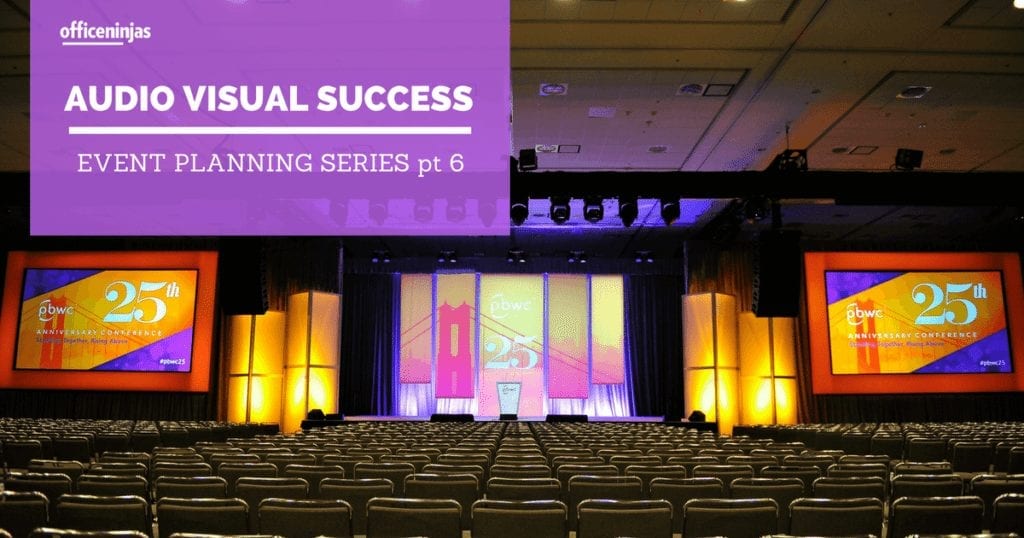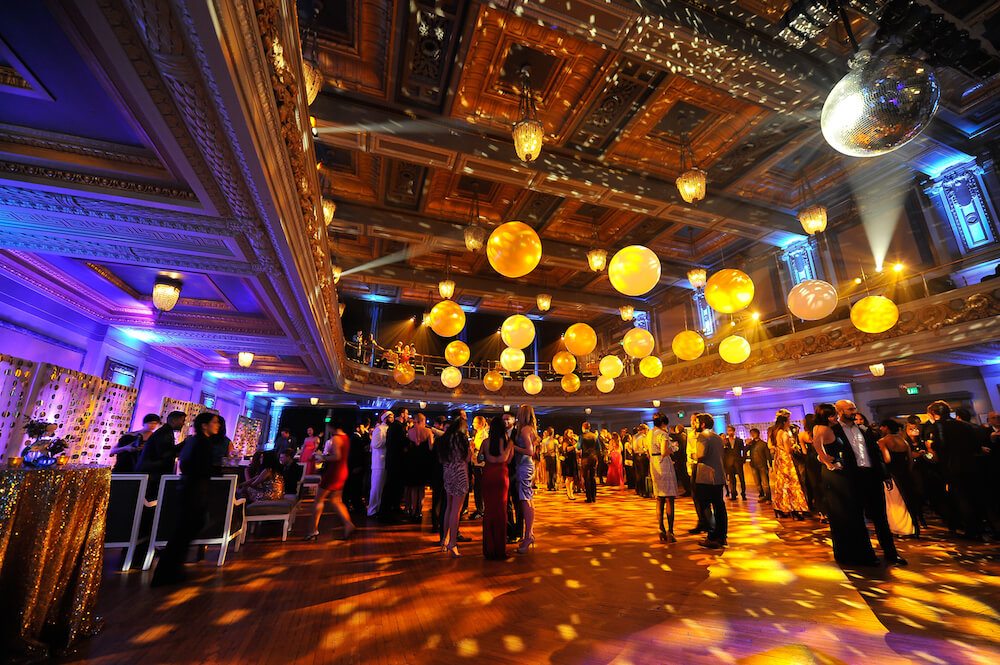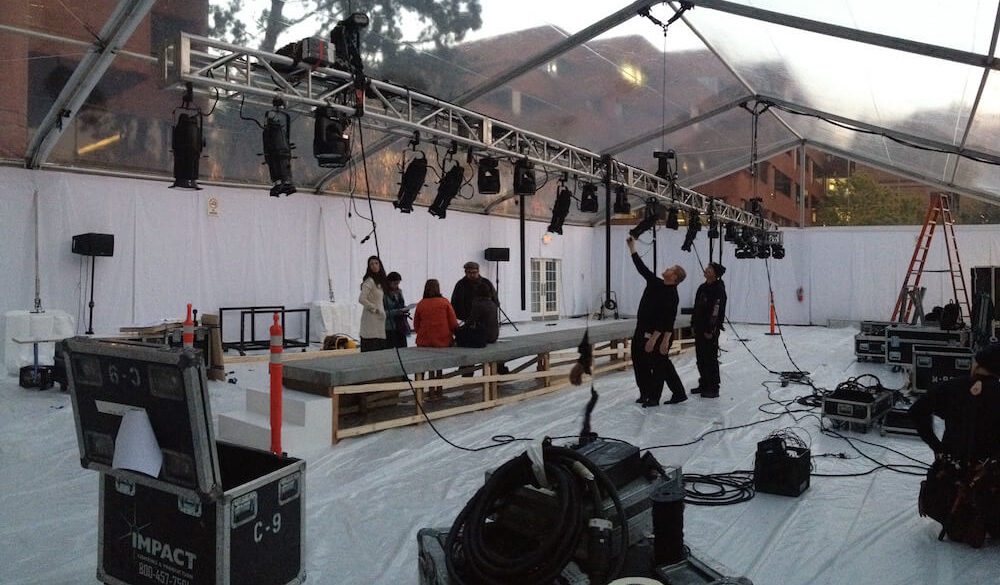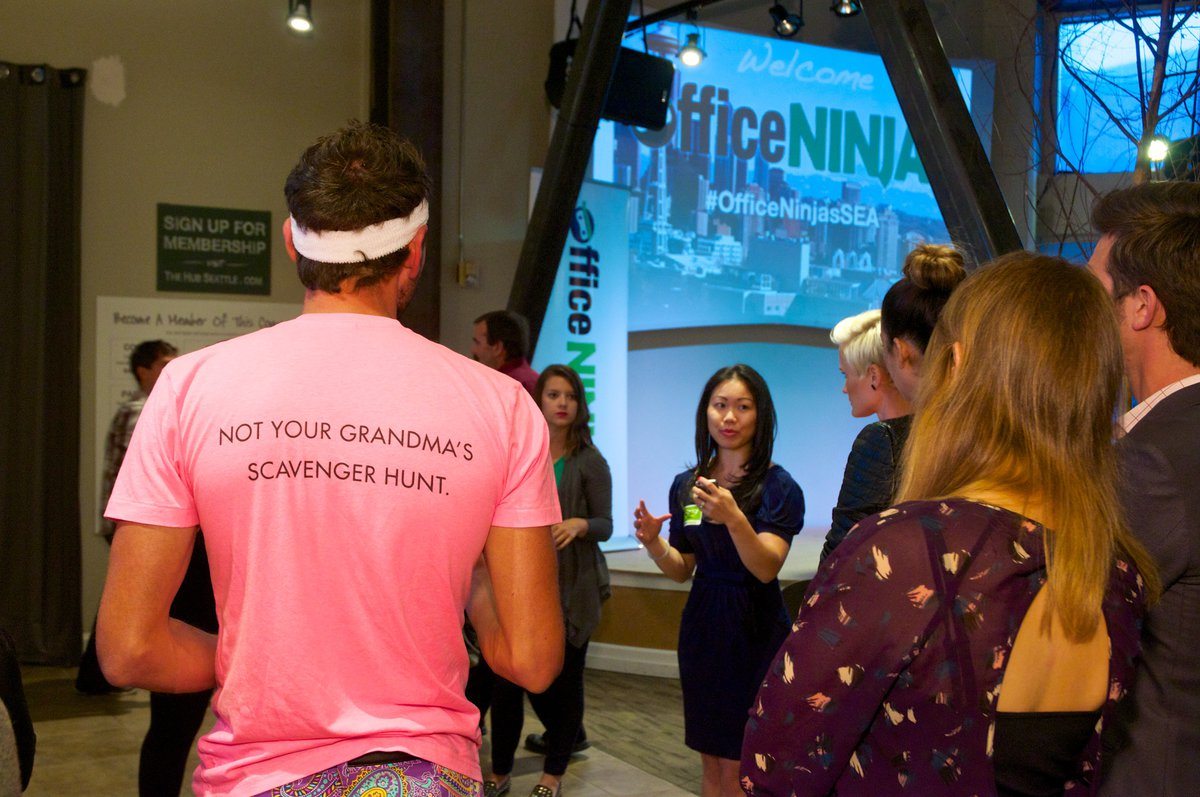Event Planning Series Part 6: Audio Visual Do’s & Don’ts

Read the Full OfficeNinjas Event Planning Series:
Experiential Events | Digital Tool Belt | Venue Checklist | F&B Planning | Photography & Photo Booths | Audio Visual | Event Design | Live Music | Corporate Gift-Giving
Planning the audio/visual (A/V) components of an event is kind of like ordering roofing materials when building a house: it’s not all that exciting (you’d rather be browsing paint swatches or shopping for furniture).
However, it’s super important. Just like a shoddy roof can destroy a house, bad A/V (dead microphones, frozen slideshows, stark lighting) can kill the energy of your event.
In the beginning, OfficeNinjas HQ had its fair share of technical difficulties, which is why we partnered with the team at Impact Lighting|Audio|Visual for events—like Admin Bash and our upcoming Homecoming Event.
Founded by two professional lighting designers who’ve been working together for decades, Impact provides A/V support and lighting design for events ranging from corporate events and conferences to holiday parties. They think of EVERY last detail, and they’ve also helped us appreciate the artistry that goes into a well-designed event.
Maybe A/V planning is more fun than browsing paint swatches after all.
We know we got lucky with Impact; not all companies worked to bring our vision to life with excellent project management like this team did. To help you achieve similar A/V success at all your future events, we worked with Impact to come up with some event A/V do’s and don’ts.
AUDIO VISUAL DO’S & DON’TS
Venue

DO double check your venue contract for any restrictions or penalties associated with using an external A/V provider instead of the in-house A/V specialist.
DON’T sign a venue contract until you’ve talked to an A/V provider. They can help review your venue contract and ensure that it includes the necessary space, equipment, and power for your event.
DO ask the venue about ‘rigging points’ if your A/V team plans to hang anything—lighting fixtures, speakers, projectors, decor—from the ceiling. Some venues charge extra for rigging points.
DON’T forget to do a site tour with your A/V provider. They’ll spot things that may not be on your radar—specs and ease of load-in dock, control room access, security, permits, backup generators, HVAC capabilities, etc.
DO reserve enough time at the venue for setup and teardown—this is a common mistake that can quickly lead to increased expenses. Not sure how much time you need? Ask your A/V provider.
Equipment

DO plan to incorporate uplighting to set the tone. Just like a new coat of paint to a home, event lighting is a relatively inexpensive yet dramatic way to enhance the look and ambiance of the venue. Take a look at Impact’s amazing use of lighting for holiday parties, corporate events, and conferences.
DON’T forget to consider the various lighting techniques available—lanterns and string lights, pin spotting centerpieces, pattern washes, and monogram/logo projection. Ask your A/V provider for a menu of recommendations on how to make your event GLOW.
DO ask the venue about their in-house lighting, sound, and audio capabilities. Check with your A/V provider to see if any of the onsite equipment is sufficient for your event.
DON’T settle for ‘good enough’ when it comes to ordering equipment. For example, if all your visual content is designed according to a 4:3 ratio, don’t order a 16:9 widescreen monitor. This kind of mismatch is what causes the dreaded black bars in the borders of PowerPoint slide shows.
DO ask about new equipment, trends, and digital capabilities such as projection mapping, multimedia elements, and LED technology.
DON’T estimate the number of audio and display inputs you need. Switchers and sound mixer boards have a limited number of inputs, so work with your A/V specialist to get an exact count on microphones, computer audio, cameras, etc.
Communication

DO set a reasonable budget. Resist the urge to cut corners on crucial services and equipment, like microphone rentals. If the A/V provider recommends that you rent four microphones, don’t assume you can get away with just two mics and a series of quick hand-offs.
DON’T make major changes to the timeline and floorplan without talking to your A/V provider. This ensures you get the correct equipment and staff to meet your new needs.
DO meet the A/V team well before the event. Take the time to discuss your event’s theme, size, entertainment, and the venue. Share your expectations, but welcome the team’s feedback and expertise. They may have some great ideas to incorporate your brand into the lighting and audio design. (Take a look at the dynamic LED dance floor that Impact created for the International Special Events Society)
DON’T expect your A/V provider to read your mind. Show them examples of designs and layouts that you like and don’t like.
DO create an info packet for the A/V team. It should include the timeline, run of show, floor plan, contact information for your team (in case you’re unavailable), as well as a list of other vendors involved, details on load-in and load-out, and parking information. You may have covered everything in emails and meetings, but it’s helpful to have all pertinent information in one place.
These conversations will help you develop a rapport with the team prior to the event, which can be incredibly helpful when it’s time to party. Susan Sheinkopf, Director of Sales & Marketing at Impact shares,
Trusting your vendors to do a great job and communicating along the way is a big part of the success of an event, so take the time build solid relationships BEFORE you need them. That way, when an issue comes up, you’ll know who to call and will feel comfortable doing so.
T-Minus …
![]()
DON’T skip the dry run. Hold a technical rehearsal before the event so you can get in front of any potential problems. All A/V content should be loaded onto a single laptop (relying on online content is a big no-no) and emailed to the A/V provider, as well.
DO have a Plan B. Even the most well-coordinated events have been known to hit a snag or two. Think about every step of your program, how it could go wrong, and what you can do to be prepared for that situation. That might entail having backup drives on hand, creating printed hand-outs, or compiling all presentations into a single file. A seasoned A/V vendor can help you identify and plan for potential problems.
Our hope is that you’ll take this advice, find a crackerjack A/V team, and never need to utter the words, “Sorry, folks, we’re experiencing some technical difficulties.”
Have you worked with an A/V team? What’s your best tip for pulling off a seamless event?
Great article! And yes, the tech rehearsal is CRITICAL – there’s nothing worse than being in the middle of a presentation and the embedded video clip doesn’t work. It also helps with the event timing and flow. Also, If live music is involved before/after/during, it also helps you to cue the musicians for when they can take a break and for how long. Having an A/V Pro you trust takes a lot of worry off your plate!
Linda, it’s obvious that you’ve planned your fair share of events. Giving musicians a designated break time is an EXCELLENT idea!